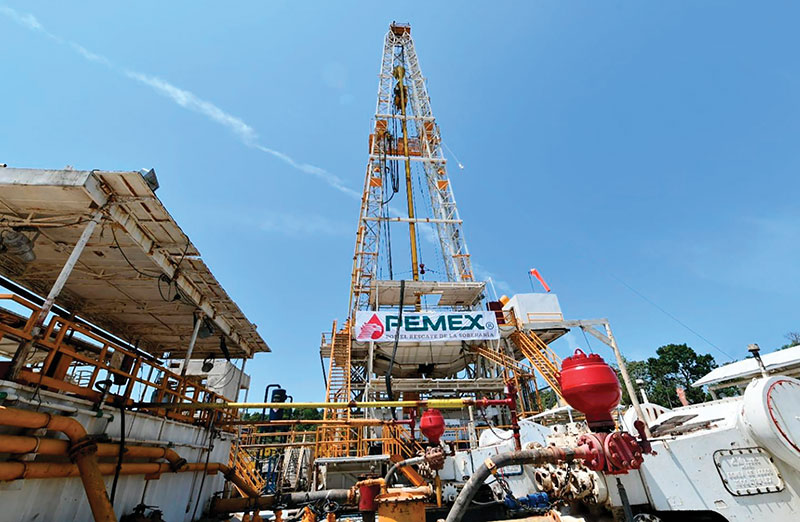Mexico's Pemex Destroyed Resources Worth $342 Million from Two Top Gas Fields
(Reuters) — Mexican state oil company Pemex illegally burnt off hydrocarbon resources worth more than $342 million in the three years up to August 2022 at two of its most important new fields, internal documents from the country's oil regulator showed.
The three documents, produced by the regulator and dated August 2022, detail how Pemex destroyed resources worth $275 million from the Ixachi field in three years and $67 million from the Quesqui field in two years.
To calculate the value, the regulator used prices from non-public contracts to commercialize such hydrocarbons.
Neither Pemex nor the energy ministry responded to requests for comment.
Late last year, Pemex said it would stop the flaring practice at Ixachi following Reuters reports on development plan violations at the two fields and related fines.
Under pressure to meet ambitious production goals by Mexican President Andres Manuel Lopez Obrador, has repeatedly been fined by the oil regulator for violating its own pledges for the development of the Ixachi and Quesqui fields.
The plans, for the exploration and production of natural gas and other hydrocarbons in the southeastern states of Veracruz and Tabasco, were approved by the regulator — which is responsible for ensuring compliance.
Burning off gas and condensate - a mixture of liquid hydrocarbons similar to a very light crude oil - has also resulted in extensive environmental damage.
Reuters reported last year that Pemex had been excessively flaring gas across the region, but the value of the destruction has not previously been reported.
Mexico — the world's eighth-biggest gas flarer — is under increasing pressure, including from the United States, to cut the practice and methane emissions.
Managing emissions is set to become more challenging as fields age and the world's most indebted oil company lacks sufficient funds to upgrade ailing infrastructure.
In Ixachi, the destruction was particularly dramatic because production started a year earlier. There, the documents show Pemex burnt off some 62.9 billion cubic feet of gas and 310,000 barrels of condensate.
That is the equivalent of 31% of the total amount of gas produced from the field, and 1.3% of total condensate, according to Reuters calculations.
The documents were sent to the country's energy minister, Rocio Nahle, the head of regulatory compliance at Pemex's exploration and production arm, and senior officials at the regulator and the interior ministry.
Missing Infrastructure
Pemex produced 201.2 billion cubic feet of gas and 24.3 million barrels of condensate from Ixachi. But it still fell short of its targets.
The documents also show that 77.6% of the investment into the field Pemex had pledged in its development plan — totaling $2.9 billion — were not made.
Lopez Obrador declared early on in his presidency that Ixachi and Quesqui formed part of 17 new priority fields expected to dramatically boost national production as part of a wider effort to make the country energy independent.
The fields were meant to receive more resources so Pemex can start exploration and production earlier and faster and make up for declining production from ageing fields elsewhere.
But Pemex failed to complete the wells, pipelines and other infrastructure needed to produce gas and condensate from the fields without high levels of waste.
In Ixachi, the destruction of value from burning off condensate was more than $21 million in three years; in Quesqui, it was almost $8 million in two years, the documents show.
It has not previously been reported that condensate was also burnt off at the fields. Under Mexican law, documentation around such violations is not made public.
"The objective should be to maximize making use of all hydrocarbon products in the field," one of the documents said, adding that "(Pemex) does not meet production it committed to because wells and infrastructure are not in place".
In the documents, the regulator also recommends changes so that Pemex "avoids the burning off and the destruction of commercial value of the hydrocarbon products."
Pemex has historically deemed investing in infrastructure to explore and produce gas too expensive and instead imported much of it from the United States.
In recent years, it has come under pressure because of the environmental damage associated with burning off gas.
Late last year, Pemex acknowledged in its updated business plan for 2023 to 2027 that its poor environmental, social and governance (ESG) record risked hurting its financing as rivals were transitioning faster to clean energies.
Related News
Related News

- Keystone Oil Pipeline Resumes Operations After Temporary Shutdown
- Biden Administration Buys Oil for Emergency Reserve Above Target Price
- Freeport LNG Plant Runs Near Zero Consumption for Fifth Day
- Enbridge to Invest $500 Million in Pipeline Assets, Including Expansion of 850-Mile Gray Oak Pipeline
- Mexico Seizes Air Liquide's Hydrogen Plant at Pemex Refinery
- Evacuation Technologies to Reduce Methane Releases During Pigging
- Editor’s Notebook: Nord Stream’s $20 Billion Question
- Enbridge Receives Approval to Begin Service on Louisiana Venice Gas Pipeline Project
- Mexico Seizes Air Liquide's Hydrogen Plant at Pemex Refinery
- Russian LNG Unfazed By U.S. Sanctions





Comments